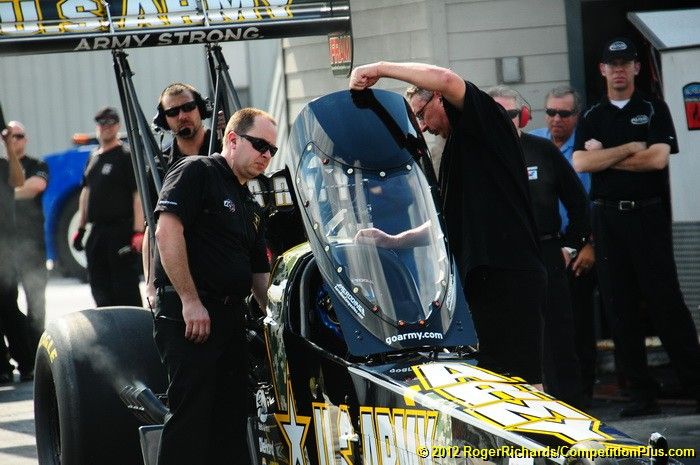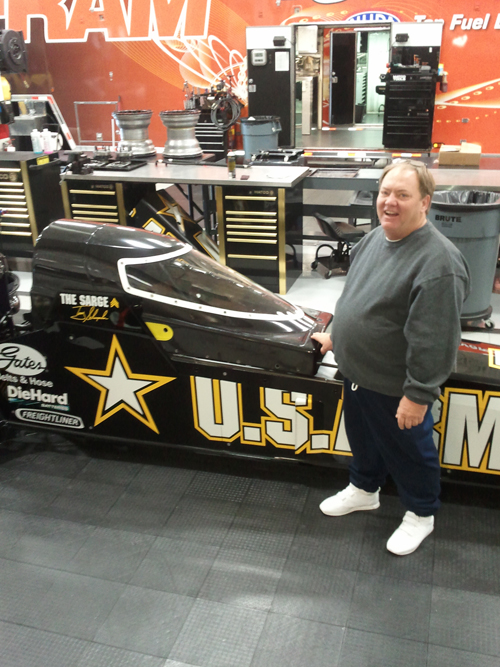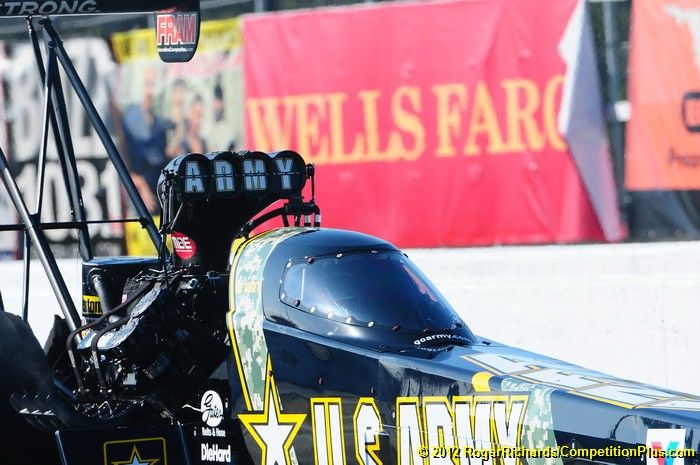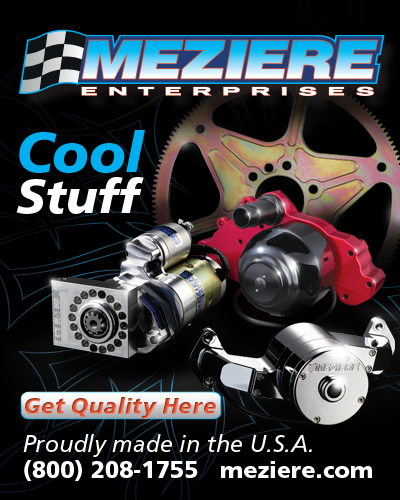'WHAT SEEMS TO BE THE PROBLEM?' DSR DEVICE DESIGNER ASKS
 James Brendel, virtually born to the task of engineering racing boats to protect the drivers, said he understands completely why NHRA Top Fuel racers need cockpit protection, complete with a sturdy canopy. And he said he understands the NHRA needing to do due diligence before approving the device he designed to solve the problem.
James Brendel, virtually born to the task of engineering racing boats to protect the drivers, said he understands completely why NHRA Top Fuel racers need cockpit protection, complete with a sturdy canopy. And he said he understands the NHRA needing to do due diligence before approving the device he designed to solve the problem.
What he said he doesn't understand is the sanctioning body's delay in approving the joint project between Don Schumacher Racing and Indianapolis-based Aerodine Composites Group.
Brendel designed the prototype at the urging of and with the co-operation with U.S. Army Dragster crew chief Mike Green, and he said, "It's absolutely ridiculous what the NHRA is doing, not letting them run this."
The designer said, and Green confirmed, that this next weekend's SummitRacing.com Nationals at The Strip at Las Vegas Motor Speedway will mark two years since Green gave Brendel a roll cage from the U.S. Army Dragster to use in building the prototype.
James Brendel, virtually born to the task of engineering racing boats to protect the drivers, said he understands completely why NHRA Top Fuel racers need cockpit protection, complete with a sturdy canopy. And he said he understands the NHRA needing  James Brendel, designer of the enclosed cockpit prototype used on the DSR dragsters, doesn't understand what the hold up is in the NHRA'ds approval process. He believes the NHRA could face a legal issue if someone gets injured in an accident where this device is available and is still unapproved.to do due diligence before approving the device he designed to solve the problem.
James Brendel, designer of the enclosed cockpit prototype used on the DSR dragsters, doesn't understand what the hold up is in the NHRA'ds approval process. He believes the NHRA could face a legal issue if someone gets injured in an accident where this device is available and is still unapproved.to do due diligence before approving the device he designed to solve the problem.
What he said he doesn't understand is the sanctioning body's delay in approving the joint project between Don Schumacher Racing and Indianapolis-based Aerodine Composites Group.
Brendel designed the prototype at the urging of and with the co-operation with U.S. Army Dragster crew chief Mike Green, and he said, "It's absolutely ridiculous what the NHRA is doing, not letting them run this."
The designer said, and Green confirmed, that this next weekend's SummitRacing.com Nationals at The Strip at Las Vegas Motor Speedway will mark two years since Green gave Brendel a roll cage from the U.S. Army Dragster to use in building the prototype.
The approval process has gone more slowly than many would like.
Glen Gray, NHRA vice-president of technical operations, told Competition Plus during the Winternationals in February, "We don't want to drag this out for a long time. We promised Aerodine and Don Schumacher Racing we would expedite this as quickly as possible -- and without spending a lot of money. If it's some very high cost, then that would get amortized across the canopy program, and it might make it not feasible for anybody to purchase the thing."
However, in a Competition Plus article published March 21, Gray said, "There is no hard-and-fast timetable on that [ruling about the device]. We are not going to rush through it."
Green said he spoke Friday morning with an NHRA representative who told him to expect an "update" later in the day. If an update came, Competition Plus is unaware of it.
So the NHRA has no answer for Brendel, who said, "I just don't understand what their hang-up is.
"They need to get with the program. They're being unfair to everybody," Brendel said of the NHRA. "It's just a mess that needs to be cleared up. They're doing nothing but getting one step closer to the danger zone."
He said if a fatal accident occurs and this device clearly could have prevented it, "the NHRA wouldn't be able to come up with enough insurance money" to pay a legal judgment. "God forbid anything should happen. We don't need another catastrophe.
"It's for the advancement of the sport. It's safer than anything that's ever been on a race course. What seems to be the problem?" Brendel asked.
At question for the NHRA first was whether this revolutionary modification to the dragster served a safety purpose or an aerodynamic one. Today the key question the sanctioning body is asking seems to be whether the Safety Safari can extract a driver from a crashed dragster if the device is on the car.
Brendel said, "I just happen to know more about this subject than anybody on the face of the planet." And he said he built it with a latch that works from the outside of the canopy, as well as with a latch that works from inside the cockpit.
"The driver can open it from the inside himself. If he's knocked out, there's also a tucked-away cable with a knob on the end of it that opens the capsule from the outside, same thing we have on the boats. There's an emergency release from the outside, in case the driver's knocked out," Brendel said.
The boat-racing industry, Brendel said, requires that a capsule with canopy include an emergency release to reach a racer from the outside. Those devices, he said, are engineered to be removed in their entirety (everything but the floor panel) in 30 seconds. He mentioned, though, that no one from the NHRA "has bothered to time themselves on how fast they can take it on and off the car."
Brendel bristled at the accusation that the device is an aerodynamic enhancement disguised as a piece of safety equipment.
"If they're that worried about it enhancing the aerodynamics that much, why don't they just make everybody with a dragster take their bodies off, like they used to run them in the old days -- with all the wind flying through all the tubing -- and create mayhem from Point A to Point B? They definitely won't let them do that. They can't be upset about the weight. They can't be upset about the origination, where it came from and who was involved. I have ultra-hands-on experience."
Overall, Brendel said, "I think it's good that they're looking at the thing real hard. But the thing is they're having somebody with absolutely zero experience look at it. They don't know what they're looking for. They are dealing with something they know nothing about.
"It would be different if they had a pile of bonafide, qualified group of people who are used to doing something like this," Brendel said, adding that the boat-racing industry has an organization called the Union of International Motorboating, which is like the FIA of boat racing. He said, "These guys all have PhDs in mechanical engineering, PhDs in chemical engineering. They actually know what they're doing."
How strong is it?
Among the sanctioning body's concerns was the effectiveness of the canopy. Racers have shared accounts of items that accidentally reached their cockpits, and Brendel said his device undoubtedly can protect the drivers.
When Brandon Bernstein's dragster hopped the guard wall in 2003, at Englishtown, N.J., the driver said he remembered something black falling into the cockpit. He said he wondered what it was, telling himself in that fraction of a second, "We don't have anything on the race car that looks like that." They didn't. It turned out to be one of the fireworks pots stationed along the wall.
Both Tony Schumacher and Gary Scelzi have said they have encountered birds flying into their cockpits. And, Brendel said of the racers, "They can't dodge them. They certainly can't duck. All that's got to do is hit them in the face and they're dead."
While that might be a bit alarmist, it is certain that such an incident with a bird could cause a loss of control of the car or cause injury. Certainly an errant part or piece could do even more damage, à la Felipe Massa at Formula 1's Hungarian Grand Prix.
"They [the manufacturers] actually test the F-16 canopies with what they call a simulated bird-strike test. They shoot a dead chicken out of a stream cannon at 550 knots [633 mph] . . . and they [gauge] how much the windshield deflects and how much it springs back. So we've got a pretty good grasp of what the strength characteristics need to be. And it's attached on there pretty good."
Thanks to Brendel's handiwork, one survivor of an almost-indescribably nasty crash is a boat racer named Bob Pizza. In the "What A Tomato" alcohol hydroplane, Pizza was racing in the late 1990s on California's Sacramento River, on the Red Bluff course, using a Brendel-built capsule.
 Said Brendel, "The throttle stuck wide open, and he went through the timing lights at 227 miles an hour, hit the parachutes, shut the fuel off, shut the motor off, and it just kept going. He pulled the parachutes, and it just blew those off the back of the boat. The thing went for another half a mile Who knows how fast it was going -- 260? 270? 280, maybe?
Said Brendel, "The throttle stuck wide open, and he went through the timing lights at 227 miles an hour, hit the parachutes, shut the fuel off, shut the motor off, and it just kept going. He pulled the parachutes, and it just blew those off the back of the boat. The thing went for another half a mile Who knows how fast it was going -- 260? 270? 280, maybe?
"It hit the Red Bluff Diversion Dam -- that's an inch-and-a-quarter thick, solid steel -- perpendicular, going full-tilt boogie. The boat blew in a million pieces and the capsule bounced back and was sitting there, floating in the water. The only thing that happened to the guy was it broke his eardrums from the noise of hitting the dam," he said. "He had a couple of small bruises where the belts hold him in. He wasn't wearing any kind of HANS device.
"This thing has been crash-proven so many times that it's unbelievable," Brendel said. "It's damn-near indestructible."
According to Brendel, one of the NHRA Technical Committee members among a group inspecting the canopy this February at Pomona pointed to it and asked, "How do we know if that windshield is strong enough?" And Mike [Green] said, "That's a half-inch thick, and the windshield that you let us run right now is 100-thousandths-of-an-inch thick."
Brendel's thinking, he said, was "How could you possibly even bring that subject up? It's totally a moot issue. Why are you arguing about a windshield that's 500-percent stronger?
"It's got the canopy of a F-16 jet fighter on it. It's made to go 3,000 mph," he said. "I had to shrink it down a little bit. The only reason it's not the same thing is the one that goes on the plane and what goes on the boat is 33 inches wide and the car is only 22 inches wide. I had to narrow it up, but I did not change the front-to-rear characteristics of the top of it. It's there to protect the driver's face. That is all they should be worried about: what that thing's made of and how it's held on there."
What's in a name?
Brendel has referred to the piece as an "enclosed driver cockpit safety system for dragsters" and described it as an "enclosed driver protection device."
He took offense at the label of "canopy," saying a canopy is one component of the whole piece. If he had to choose between the descriptions of "canopy" and "capsule," he said he would choose the latter, for "what I designed, built, and delivered to DSR and then Aerodine . . . [is] a total surround -- front, back, sides, bottom, and top -- enclosure with an intricate safety latching system . . . bolt-on, fully enclosed driver cockpit safety system for dragsters."
However, Green said "canopy" is the correct word, based on the evolution of the device as it appears now for Aerodine and DSR. He and the Aerodine engineers refer to it as a "canopy."
To clarify further, Brendel calls himself the device's designer and builder of the molds and prototype and owns the utility patent on the device. He said he sold the project to Aerodine "because it's a respectable manufacturing company that deals with the NHRA and IndyCar, and they have all of the right, very expensive tooling equipment. I'm just one guy. I'm a design engineer. I'm not a manufacturer, and the chances of Aerodine being able to build 50 of those things is a lot greater than me being able to build 50."
He said, "I have signed a contract. The stuff is owned by Aerodine. That includes everything that is on the U.S. Army car: the molds for the paneling, the molds for what goes over the driver's head, the molds that hold the windshield, the molds that manufacture the windshield. They have everything. Aerodine is in control of the entire project."
He said he still is working with Aerodine on many projects, including an IndyCar version of this device that DSR has tested. That project, he said, is in the negotiation stages and he isn't at liberty to say which team is (or teams are) involved.
Long history of concern
Brendel, 54, owns Brendel Safety Capsules & Hondo Boats Inc., and his family has a long history in fabrication for the boat-racing industry. At age 16, he built the first racing boat that clocked 200 mph on its maiden run -- with a motor handcrafted by Dan Olson, the crew chief who guided Tony Schumacher to the first of seven Top Fuel titles and later served as the NHRA's director of Top Fuel and Funny Car Racing.
"I've been building these enclosed cockpits for 26 years. I absolutely changed the course of history in powerboat racing worldwide," Brendel said. "I have been doing these enclosed cockpits that crash just as fast as [drag racers] go. There have been some people to copy them, made some cheap imitation copes and there's nothing I can do about, and they're the only people who have gotten hurt. In 26 years, there's only been 14 guys to get killed in them and all of them were killed in cheap imitation copies. And half of them have been [killed] because . . . of mistakes that should have never, ever been made."
Brendel also has designed and built various components for use in drag racing, including use in the nitro ranks and Top Alcohol Dragster and Top Alcohol Funny Car classes.
More than 25 years ago, he and Charlie Allen, who today is the track operator at Firebird International Raceway near Phoenix, shared an interest in drag boat racing. Back then, Allen owned the IHBA, the International Hot Boat Association.
"He announced that until somebody made something that will protect the driver, there will be no more boat racing in Top Fuel or Top Alcohol. He came to me and said, 'I know you're the only guy who can do this. You need to do it, and you need to do it now,' " Brendel said.
"So I started on it, and about three months later there was a prototype to run and we ran it. As a result of conversations with Charlie Allen, about our mutual concerns regarding the number of deaths which had occurred in water motorsports over the years, I designed and built the first drag boat capsule," he said. "About four months later, a guy crashed and walked away without a scratch on him.
 "Everybody kept saying, 'This thing will never work' and 'It'll be a coffin. You'll just bury people in it.' That's so far-fetched from the amount of engineering that went into it," he said. "Since then, I have continued manufacturing capsules for boats, updating their design by reviewing accidents and modifying my designs by incorporating the newest state-of-the-art materials whenever and wherever it is appropriate."
"Everybody kept saying, 'This thing will never work' and 'It'll be a coffin. You'll just bury people in it.' That's so far-fetched from the amount of engineering that went into it," he said. "Since then, I have continued manufacturing capsules for boats, updating their design by reviewing accidents and modifying my designs by incorporating the newest state-of-the-art materials whenever and wherever it is appropriate."
Brendel and Green met years ago, also through boat racing.
"I worked at a machine shop that built racing engines, and they had a blown alcohol hydro [hydroplane racing boat] there. We used to go to the boat races, and I met him through that," Green said.
Brendel, who lives in Riverside, Calif., said, "I brought the prototype down to Pomona two years ago, and I showed it to Dan Olson and Graham Light (NHRA senior vice-president of racing operations) and Tom Compton (NHRA president), and they said it was good, that they were really impressed. I took it to [Olson] and I met him in front of the [Wally Parks NHRA Motorsports] Museum. They brought a bunch more people down [to the Museum]. They looked at it for about 45 minutes to an hour."
He said he later "had a meeting with them without involving Mike Green, without involving Don Schumacher, because at that point it was solely mine."
He said Olson told him, "This is the most impressive thing I've ever seen in my life. If they had said 'No' then, I would have stopped."
Brendel said the day after he showed it to Olson and the NHRA contingent, Mike Neff suggested he approach Aerodine, because Aerodine has the proper equipment to fashion and perfect the device.
A matter of trust
"I've known Mike Green for all of my life, and he's been trying to get this thing done forever," Brendel said, adding that Green spoke to Don Prudhomme about it when he was working at Snake Racing in the early 2000s "and Prudhomme just thought it was too much money."
But he said Green has wanted to do this project for many years and has wanted it to be done correctly. "If he thought there was someone else better to do this job," Brendel said, "he would have found him. Fortunately, we just happen to be very good friends."
He said, too, that he and Green were "frustrated with losing friends in crashes over the years."
Brendel said, "Mike Green doesn't want to be the crew chief on a car in which the driver gets killed. Nobody does. At least he's got enough balls to do something about it.
"This was not Don Schumacher's idea. This was not Tony Schumacher's idea. It was Mike Green's idea," he said. "If you think that Mike Green in your wildest dream would be putting something out there that is unsafe, you're very incorrect. He wouldn't have come to me if he didn't think I could have handled the job. I wouldn't have shipped the stuff if I thought there was a problem. The job has ended up in their lap and Aerodine's lap."
When will this canopy device be approved?
Who knows?
All Brendel had left to say was that NHRA officials "need to get their act together. Don [Schumacher] trusts Mike Green quite a bit, and Mike Green trusts me quite a bit. Obviously, we all trust Steve at Aerodine. What are they waiting for?"
It's question he said he wants someone to answer -- soon.



































